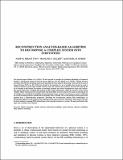Por favor, use este identificador para citar o enlazar a este item:
http://hdl.handle.net/10261/30576COMPARTIR / EXPORTAR:
 SHARE SHARE
 CORE
BASE CORE
BASE
|
|
| Visualizar otros formatos: MARC | Dublin Core | RDF | ORE | MODS | METS | DIDL | DATACITE | |

| Campo DC | Valor | Lengua/Idioma |
|---|---|---|
| dc.contributor.author | Mirats-Tur, Josep M. | - |
| dc.contributor.author | Cellier, François E. | - |
| dc.contributor.author | Huber Garrido, Rafael | - |
| dc.date.accessioned | 2010-12-17T13:32:25Z | - |
| dc.date.available | 2010-12-17T13:32:25Z | - |
| dc.date.issued | 2004 | - |
| dc.identifier.citation | International Journal of General Systems 33(5): 527-551 (2004) | - |
| dc.identifier.issn | 0308-1079 | - |
| dc.identifier.uri | http://hdl.handle.net/10261/30576 | - |
| dc.description.abstract | Two previous papers [Mirats et al. (2002a) On the selection of variables for Qualitative Modelling of Dynamical Systems, International Journal of General Systems 31(5) pp. 435–467; Mirats et al. (2002b) Variable selection procedures and efficient suboptimal mask search algorithms in Fuzzy Inductive Reasoning, International Journal of General Systems 31(5), pp. 469–498] were devoted to the selection of a set of variables that can best be used to model (reconstruct) a given output variable, whereby only static relations were analysed. Yet even after reducing the set of variables in this fashion, the number of remaining variables may still be formidable for large-scale systems. The present paper aims at tackling this problem by discovering substructures within the whole set of the system variables. Hence whereas previous research dealt with the problem of model reduction by means of reducing the set of variables to be considered for modelling, the present paper focuses on model structuring as a means to subdivide the overall modelling task into subtasks that are hopefully easier to handle. The second and third sections analyse this problem from a system-theoretic perspective, presenting the reconstruction analysis (RA) methodology, an informational approach to the problem of decomposing a large-scale system into subsystems. The fourth section uses the fuzzy inductive reasoning (FIR) methodology to find a possible structure of a system. The study performed in this paper only considers static relations. | - |
| dc.language.iso | eng | - |
| dc.publisher | Taylor & Francis | - |
| dc.rights | openAccess | - |
| dc.subject | Model structuring | - |
| dc.subject | Variable selection | - |
| dc.subject | Behavioural modelling | - |
| dc.subject | Model reduction | - |
| dc.subject | Inductive modelling | - |
| dc.subject | Fuzzy inductive reasoning | - |
| dc.subject | Control theory | - |
| dc.title | Reconstruction analysis-based algorithm to decompose a complex system into subsystems | - |
| dc.type | artículo | - |
| dc.identifier.doi | 10.1080/03081070310001645993 | - |
| dc.description.peerreviewed | Peer Reviewed | - |
| dc.relation.publisherversion | http://dx.doi.org/10.1080/03081070310001645993 | - |
| dc.type.coar | http://purl.org/coar/resource_type/c_6501 | es_ES |
| item.openairecristype | http://purl.org/coar/resource_type/c_18cf | - |
| item.fulltext | With Fulltext | - |
| item.cerifentitytype | Publications | - |
| item.openairetype | artículo | - |
| item.languageiso639-1 | en | - |
| item.grantfulltext | open | - |
| Aparece en las colecciones: | (IRII) Artículos | |
Ficheros en este ítem:
| Fichero | Descripción | Tamaño | Formato | |
|---|---|---|---|---|
| doc1.pdf | 257,36 kB | Adobe PDF |  Visualizar/Abrir |
CORE Recommender
SCOPUSTM
Citations
2
checked on 17-abr-2024
WEB OF SCIENCETM
Citations
1
checked on 22-feb-2024
Page view(s)
319
checked on 19-abr-2024
Download(s)
260
checked on 19-abr-2024
Google ScholarTM
Check
Altmetric
Altmetric
NOTA: Los ítems de Digital.CSIC están protegidos por copyright, con todos los derechos reservados, a menos que se indique lo contrario.
